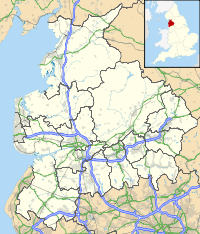- St James' Church, Wrightington Bar
-
St James' Church, Wrightington Bar
St James' Church, Wrightington Bar, from the southLocation in Lancashire Coordinates: 53°37′01″N 2°43′03″W / 53.6169°N 2.7175°W OS grid reference SD 526 136 Location Wrightington Bar, Lancashire Country England Denomination Anglican Website St James, Wrightington History Dedication Saint James Consecrated 1857 Architecture Status Parish church Functional status Active Heritage designation Grade II Designated 19 August 1988 Architect(s) E. G. Paley Architectural type Church Style Gothic Revival Completed 1857 Specifications Materials Sandstone rubble, slate roof Administration Parish Wrightington Deanery Chorley Archdeaconry Blackburn Diocese Blackburn Province York Clergy Vicar(s) Revd Roger Townley St James' Church, Wrightington Bar, is in the village of Wrightington Bar, Lancashire, England. It is an active Anglican parish church in the deanery of Chorley, the archdeaconry of Blackburn, and the diocese of Blackburn.[1] The church has been designated by English Heritage as a Grade II listed building.[2] It stands in Church Lane to the west of the village.[3]
Contents
History
The church was designed by the Lancaster architect E. G. Paley, and consecrated in 1857.
Architecture
Exterior
St James' is constructed in sandstone rubble and has a slate roof. Its plan consists of a four-bay nave with a south aisle, a south porch, and a chancel. At the west end is a rose window, above which is a gabled bellcote. Along the north wall of the nave are four pairs of lancet windows, between which are buttresses, and along the south wall of the aisle are three similar windows. The chancel has two lancets in the south wall, and a triple stepped lancet window at the east end.
Interior
Inside the church is an arcade carried on alternate round and octagonal piers. The church has an open timber roof.[2][4] The two-manual organ was made in 1916 by Jardine of Manchester and modified in about 1985 by Pendlebury of Cleveleys.[5] The authors of the Buildings of England series express the opinion that the church is "nothing special".[4]
See also
- List of ecclesiastical works by E. G. Paley
References
- ^ St James the Great, Wrightington w Heskin, Church of England, http://www.achurchnearyou.com/wrightington-heskin-st-james-the-great/, retrieved 22 May 2011
- ^ a b "Church of St James, Wrightington", The National Heritage List for England (English Heritage), 2011, http://list.english-heritage.org.uk/resultsingle.aspx?uid=1073009, retrieved 22 May 2011
- ^ Wrightington Bar, Streetmap, http://streetmap.co.uk/grid/352549_413638_120, retrieved 22 May 2011
- ^ a b Hartwell, Clare; Pevsner, Nikolaus (2009) [1969], Lancashire: North, The Buildings of England, New Haven and London: Yale University Press, p. 712, ISBN 978-0-300-12667-9
- ^ Lancashire, Wrightington, St. James the Great, Church Lane (E01392), British Institute of Organ Studies, http://www.npor.org.uk/cgi-bin/Rsearch.cgi?Fn=Rsearch&rec_index=E01392, retrieved 22 May 2011
Categories:- Church of England churches in Lancashire
- Diocese of Blackburn
- Grade II listed churches
- Grade II listed buildings in Lancashire
- Gothic Revival architecture in England
- 19th-century Anglican church buildings
- Religious buildings completed in 1857
- E. G. Paley buildings
Wikimedia Foundation. 2010.


